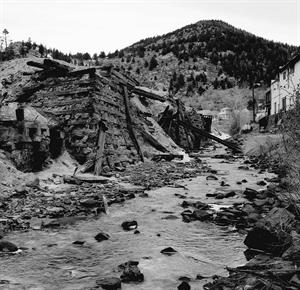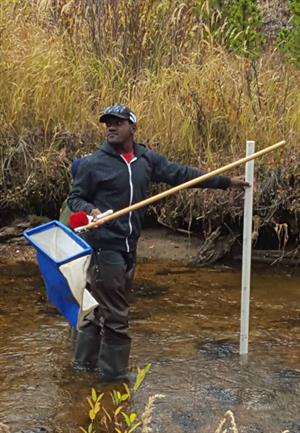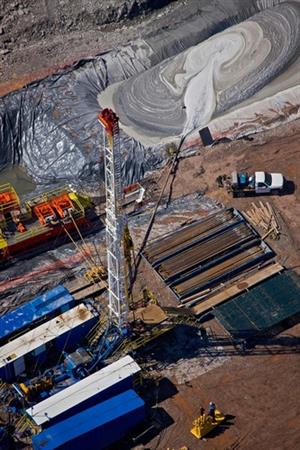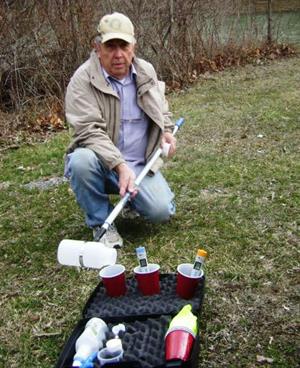America’s waterways often pay the price for “progress.” Whether it’s acid mine drainage in Colorado, toxic algal blooms in Florida, dead zones in the Gulf of Mexico and Chesapeake Bay, or fracking wastewater in Pennsylvania, contaminants wind up in our streams, rivers, and lakes as a result of what happens on land.
Sometimes the effect is immediate. Sometimes it shows up decades later. How can we identify pollution problems and ensure water quality is restored?
It starts with having a “baseline” for stream health. What’s the normal range for your stream? Perhaps the pH level always runs high due to limestone in the stream banks. Or perhaps your stream always has a perfectly healthy mid-range pH level of seven – that is, until a chemical spill causes the pH level to drop. Having a baseline is essential for measuring changing conditions in local streams and rivers and understanding what may be contributing to those changes.
That’s exactly how data collected by volunteer stream monitors in Colorado was used.
Orange Colorado Rivers Aren’t Full of Gold
Most of us only experience the “gold rush” in history books or a trip to an old mining town. Colorado residents are still living with the pollution left behind by a mining boom that began more than a century ago.
 “Pikes Peak or Bust!” was the siren call for prospectors after gold was discovered in Colorado in 1859. Decades of mining left Colorado littered with more than 23,000 “abandoned mine lands” – land, water, and surrounding watersheds where ore and minerals were dug up and processed. State and federal reclamation laws weren’t passed until the 1970s, so companies could simply walk away from mines that were no longer productive, leaving behind piles of waste and holes in the ground with no plan — or funding – for cleaning it up.
“Pikes Peak or Bust!” was the siren call for prospectors after gold was discovered in Colorado in 1859. Decades of mining left Colorado littered with more than 23,000 “abandoned mine lands” – land, water, and surrounding watersheds where ore and minerals were dug up and processed. State and federal reclamation laws weren’t passed until the 1970s, so companies could simply walk away from mines that were no longer productive, leaving behind piles of waste and holes in the ground with no plan — or funding – for cleaning it up.
It’s a dirty problem few outside Colorado knew about until an abandoned mine made headlines in August 2015. That’s when U.S. Environmental Protection Agency (EPA) contractors caused a massive spill from the Gold King Mine. The area was being considered for Superfund Site designation because historic mining operations had contaminated the soil, groundwater, and surface water with heavy metals. Contractors for EPA’s Superfund Removal Program were at the Gold King Mine to assess water releases and the feasibility of further remediation. Instead, they sent 3 million gallons of polluted water spewing into Cement Creek, carrying with it almost 540 tons of toxic metals, according to EPA. Iron and aluminum turned the water orange. Lead, copper, arsenic, mercury, and other metals were of even greater concern for people downstream.
There’s nothing like a bright orange plume of water to demonstrate the science of hydrology. Polluted water from the Gold King Mine rushed down Cement Creek and drained into the Animas River. It then traveled hundreds of miles across three states, winding through mountains, forests, farm land, American Indian reservations, and cities until it reached Lake Powell – the second largest man-made lake in the United States – and the Colorado River.
The Animas River was completely “closed down” for a week. Farmers and drinking water utilities had to stop drawing water from the river. Rafting and fishing outfits had to suspend operations during a highly-profitable summer season. But it took longer for people to trust that the water was safe.

EPA pledged to restore water quality – to what? How could EPA know the pre-spill health of Cement Creek and downstream waters? Answering the question was only possible due to the work of Colorado River Watch. Volunteers have been collecting monthly chemical data, checking macroinvertebrate populations, and taking physical measurements at more than 1,000 locations across Colorado on 600+ streams and rivers – including the Animas River – for more than 25 years. Because Colorado Parks and Wildlife co-sponsors the monitoring program, water samples for metals and nutrients are sent to the agency’s Fort Collins laboratory for analysis. This was critical data to have after themine spill.
Even more important, Colorado River Watch volunteers had been sharing their data with state agencies and EPA. In fact, the volunteer data set for the Animas River is larger than any state or federal agency’s data set – and EPA used that data to determine when the river had returned to pre-spill conditions. The quality of collected data and geographic coverage of stream monitoring make Colorado River Watch a network that agencies turn to regularly to make resource, restoration, protection, and regulatory decisions.
More than 1,500 miles east in Pennsylvania, volunteers with the Izaak Walton League’s Harry Enstrom Chapter are collecting high-quality data on stream health too. Unfortunately, state agencies seem uninterested at best – hostile at worst – in using this data to track changes in water quality.
A Fracking Fracas in Pennsylvania

The Marcellus shale formation is a natural gas reserve a mile or more beneath the Earth’s surface that stretches over 48,000 square miles. Sixty-four percent of Pennsylvania sits atop the Marcellus, where Range Resources drilled the first “unconventional” natural gas well in October 2004. Only a few wells were drilled each year until 2009, when the industry really took off.
Through a process called hydraulic fracturing or “fracking,” water and sand are mixed with a cocktail of chemicals – many of them hazardous, carcinogenic, or toxic – and injected into the shale rock to crack it open and release the natural gas trapped within. Up to 40 percent of the water mixture comes back out of the well – bringing with it salts (including bromide) and radioactive materials scoured from the rock – that must be safely contained or treated.
Hydraulic fracturing in Pennsylvania was once national news: People decried the destruction of Dunkard Creek, where every living thing in a 43-mile stretch of water died in 2009. (Residents and scientists blamed fracking wastewater for the disaster.) The documentary “Gasland” showed fire pouring out of kitchen faucets in Dimock. When Dimock residents complained that their well water became cloudy with methane after hydraulic fracturing started – one well famously exploded on New Year’s Day 2009 – the drilling company claimed the methane was naturally occurring. And indeed there is naturally occurring methane underground here. But Dimock families will tell you that their well water never had enough methane to be lit on fire until the drilling started. Although the company denied any wrongdoing, it provided bottled water to Dimock families until 2011. Some families still receive water in large drums for crops and cattle; others are on their own. The company reached private settlements with families that sued.
Just like in Colorado, measures to protect public health lagged far behind resource development in Pennsylvania. Well operators in other oil- and gas-producing regions dispose of wastewater by injecting it into deep underground wells (which has been linked to earthquakes in numerous states). In Pennsylvania’s Marcellus shale region, where the land is less conducive to drilling deep-injection wells, fracking wastewater was instead treated and released back into local streams. This became a problem when high levels of bromide were discovered in streams used for drinking water.
When bromide comes into contact with chlorine at a water treatment plant, it transforms into dangerous byproducts such as trihalomethane, which can cause cancer. In 2011, the Pennsylvania Department of Environmental Protection (DEP) asked hydraulic fracturing operators to voluntarily stop sending wastewater to municipal sewage and commercial treatment plants (which the Pittsburgh Post-Gazette reported were primarily “treating” wastewater only by diluting it).
As concerns about hydraulic fracturing and improper disposal of wastewater grew, Pennsylvania residents heard a familiar refrain from drilling companies and state regulators: how do you know these pollutants weren’t in the water before? If baseline data wasn’t readily available, local residents and communities were at a disadvantage in pinpointing potential sources of pollution.
 Members of the Izaak Walton League’s Harry Enstrom Chapter – most of whom live atop the Marcellus shale formation – recognized the need for baseline water quality data to track changes in stream health. Chapter members developed protocols to test streams for indicators associated with fracking wastewater pollution: electrical conductivity (which can indicate metals in the water), total dissolved solids (the sum of salts and organic matter in the water), pH, and temperature. “If those were out of whack, we knew there was something wrong with the water,” says chapter president Ken Dufalla. What they found were pollutants coming from unexpected places.
Members of the Izaak Walton League’s Harry Enstrom Chapter – most of whom live atop the Marcellus shale formation – recognized the need for baseline water quality data to track changes in stream health. Chapter members developed protocols to test streams for indicators associated with fracking wastewater pollution: electrical conductivity (which can indicate metals in the water), total dissolved solids (the sum of salts and organic matter in the water), pH, and temperature. “If those were out of whack, we knew there was something wrong with the water,” says chapter president Ken Dufalla. What they found were pollutants coming from unexpected places.
Although bromide can be found in drainage from abandoned coal mines, “our highest reading on bromides coming out of a mine was approximately 600 to 700 parts per billion (ppb),” says Dufalla, whose father was a miner. When chapter members started testing bromide levels above and below abandoned coal mines in 2012, they found readings as high as 18,600 ppb below the mines. “There was a definite influence on the mine water,” Dufalla says, and they suspected that drillers were dumping fracking wastewater into the abandoned mines. Even with the chapter’s findings, state officials insisted the elevated bromide levels were due only to acid mine drainage.
Another way bromides could end up in abandoned mines is leaching through the ground at municipal dumps. “We have a dump here located over an abandoned coal mine that drains into the Monongahela River a quarter mile above drinking water intakes,” says Dufalla. “All our dumps are taking frack waste material and putting it into the ground – in many places, without liners! We’re getting contaminated well water left and right, but the state is saying ‘it’s natural’.”
A 2013 article in Smithsonian magazine reported that 74 facilities across Pennsylvania were still treating and releasing fracking wastewater. Moreover, when Duke University researchers tested streams below some of these treatment plants, they found highly elevated levels of radium (a radioactive substance found in Marcellus shale) in the sediment and chloride and bromide in the water.
More than 10,000 natural gas wells have been drilled in Pennsylvania using hydraulic fracturing. Production of natural gas in the state slowed between 2014 and 2016 after a glut in the market drove down prices. Now producers are ramping back up, thanks in part to new pipelines that can carry their gas to new markets. Additional drilling is likely to follow on lands where leases were purchased a decade ago.
Tracking Pollution Problems
Today, it might seem that the water quality problems in Pennsylvania have been solved – there’s so little news coverage of them now. Yet the problems persist.
 Just ask Dimock resident Pat Farnelli. She’s one of 45 million Americans whose drinking water comes from private groundwater wells – and one of the Dimock residents whose well has been contaminated. As Farnelli told NPR’s StateImpact last year, 10 years after she signed a lease to allow drilling for natural gas on her land, her well water is still undrinkable. Her family has to haul water home every week from the spring in a nearby town to use for drinking and bathing. It’s an unfamiliar concept to those of us who receive highly treated tap water every day. But even those resources could be at risk when source water is polluted.
Just ask Dimock resident Pat Farnelli. She’s one of 45 million Americans whose drinking water comes from private groundwater wells – and one of the Dimock residents whose well has been contaminated. As Farnelli told NPR’s StateImpact last year, 10 years after she signed a lease to allow drilling for natural gas on her land, her well water is still undrinkable. Her family has to haul water home every week from the spring in a nearby town to use for drinking and bathing. It’s an unfamiliar concept to those of us who receive highly treated tap water every day. But even those resources could be at risk when source water is polluted.
Dufalla emphasizes how important it is to have baseline data for a stream before any type of development – whether it’s a pipeline or a shopping center – takes place. Without baseline data, you’re likely to hear the same refrain that Harry Enstrom Chapter members heard from the state Department of Environmental Protection: “How do you know ‘x’ wasn’t there before?”
This spurs the Harry Enstrom Chapter to test even more stream sites. “Water monitoring: this is our cause,” says Dufalla. “It’s your life and your family’s life. How do you want to live it?”
Where To Draw the (Base)Line
It’s important to establish a baseline before major changes takes place in your community, such as a new construction project or pipeline installation. It’s also how you know when you have great water quality that you want to protect.
There are more than 3.5 million miles of rivers and streams across the United States. With cuts to state and federal agency budgets, the agencies responsible for ensuring our water is safe lack the personnel and other resources needed to test all of these waterways – especially the smallest (and most vulnerable) ones. That’s where you come in.
Establishing a baseline does not mean monitoring a site once. Monitoring the same location – multiple times each year or each month, depending on what you’re monitoring for – creates a baseline that you can defend. Your community could be the next Dimock. Baseline information is critical to tracking the potential impact of new development in areas around a stream, allowing your community to quickly respond to any water quality changes.
If development does take place near your stream, don’t stop monitoring! Continue checking water quality at the same sites (if it is still safe to get to them and you have permission) to compare before-and-after data.
Volunteering to monitor water quality not only provides an opportunity to learn new skills and enjoy the outdoors, it also gives us a better and deeper understanding of issues that can affect the health of local streams and rivers.
The League’s Save Our Streams program offers multiple ways you can get involved in monitoring the health of your local waters, whether you have two minutes or two hours to spare. You can also tailor your activities to fit your water quality concerns. Get started now.